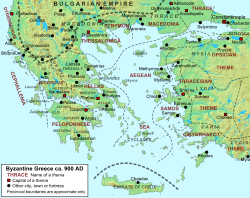Dyrrhachium (theme)
| Theme of Dyrrhachium Δυρράχιον, θέμα Δυρραχίου |
|||||
| Theme of the Byzantine Empire | |||||
|
|||||
| Map of Byzantine Greece c. 900, with the themes and major settlements. | |||||
| Capital | Dyrrhachium | ||||
| Historical era | Middle Ages | ||||
| • | Established | early 9th century | |||
| • | Norman occupation | 1081 | |||
| • | Byzantine recovery | 1084 | |||
| • | Surrendered to Venetians. | 1205 | |||
| Today part of |
|
||||
The Theme of Dyrrhachium or Dyrrhachion (Greek: θέμα Δυρραχίου) was a Byzantine military-civilian province (theme) located in modern Albania, covering the Adriatic coast of the country. It was established in the early 9th century and named after its capital, Dyrrhachium (modern Durrës).
The exact date of the theme's establishment is unclear; a strategos of Dyrrhachium is attested in the Taktikon Uspensky of c. 842, but several seals of strategoi dating from the previous decades survive. J.B. Bury proposed its creation alongside the themes of the Peloponnese and Cephallenia in the early 9th century, with the historian Jadran Ferluga putting the date of its establishment in the reign of Emperor Nikephoros I (r. 802–811). During the Byzantine–Bulgarian wars of the late 10th and early 11th centuries, the city seems to have been autonomous or at times under Bulgarian suzerainty.
From the mid-11th century on, its governor held the title of doux or katepano. In 1040–1041, the troops of the theme, under their leader Tihomir, rebelled and joined the revolt of Peter Delyan.
During the late 11th and the 12th centuries, the city of Dyrrhachium and its province were of great importance to the Byzantine Empire. The city was the "key of Albania" and the main point of entry for trade but also for invaders from Italy, and was ideally placed to control the actions of the Slavic rulers of the western Balkans. Thus the doux of Dyrrhachium became the senior-most Byzantine authority throughout the western Balkan provinces. Two successive governors, Nikephoros Bryennios the Elder and Nikephoros Basilakes, used this post as a launchpad for their imperial ambitions in the late 1070s. The region also played a crucial role in the Byzantine–Norman Wars, being occupied by the Normans in 1081–1084. After its recovery, Emperor Alexios I Komnenos entrusted the command of the theme to some of his closest relatives. Nevertheless, the city magnates (archontes) retained considerable influence and autonomy of action throughout, and it was they who in 1205, after the sack of Constantinople by the Fourth Crusade, surrendered the city to the Venetians.
...
Wikipedia

